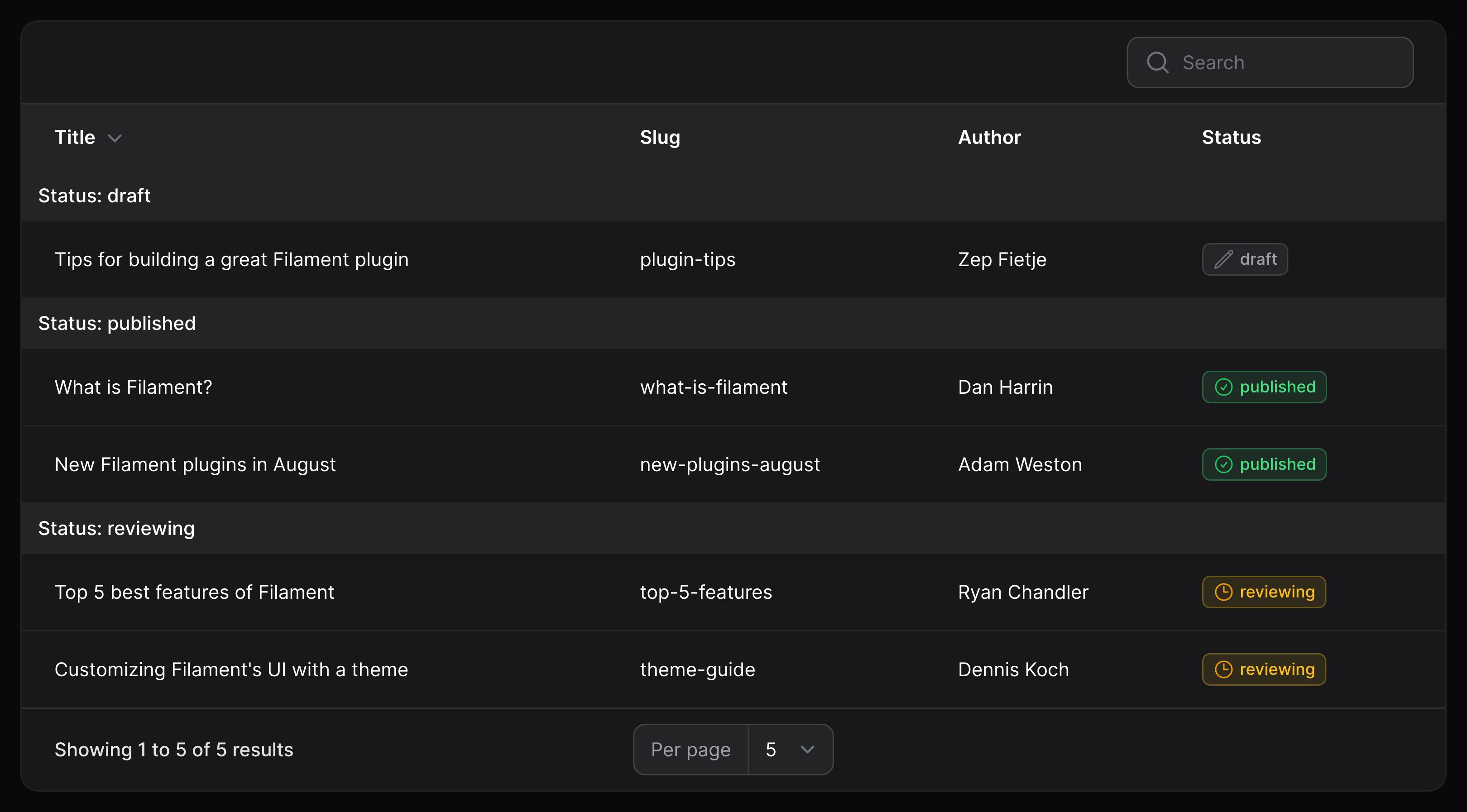Table Builder
Grouping rows
Overview
You may allow users to group table rows together using a common attribute. This is useful for displaying lots of data in a more organized way.
Groups can be set up using the name of the attribute to group by (e.g. 'status'), or a Group object which allows you to customize the behaviour of that grouping (e.g. Group::make('status')->collapsible()).
Grouping rows by default
You may want to always group posts by a specific attribute. To do this, pass the group to the defaultGroup() method:
use Filament\Tables\Table; public function table(Table $table): Table{ return $table ->defaultGroup('status');}
Allowing users to choose between groupings
You may also allow users to pick between different groupings, by passing them in an array to the groups() method:
use Filament\Tables\Table; public function table(Table $table): Table{ return $table ->groups([ 'status', 'category', ]);}You can use both groups() and defaultGroup() together to allow users to choose between different groupings, but have a default grouping set:
use Filament\Tables\Table; public function table(Table $table): Table{ return $table ->groups([ 'status', 'category', ]) ->defaultGroup('status');}Grouping by a relationship attribute
You can also group by a relationship attribute using dot-syntax. For example, if you have an author relationship which has a name attribute, you can use author.name as the name of the attribute:
use Filament\Tables\Table; public function table(Table $table): Table{ return $table ->groups([ 'author.name', ]);}Setting a grouping label
By default, the label of the grouping will be generated based on the attribute. You may customize it with a Group object, using the label() method:
use Filament\Tables\Grouping\Group;use Filament\Tables\Table; public function table(Table $table): Table{ return $table ->groups([ Group::make('author.name') ->label('Author name'), ]);}Setting a group title
By default, the title of a group will be the value of the attribute. You may customize it by returning a new title from the getTitleFromRecordUsing() method of a Group object:
use Filament\Tables\Grouping\Group;use Filament\Tables\Table; public function table(Table $table): Table{ return $table ->groups([ Group::make('status') ->getTitleFromRecordUsing(fn (Post $record): string => ucfirst($record->status->getLabel())), ]);}Disabling the title label prefix
By default, the title is prefixed with the label of the group. To disable this prefix, utilize the titlePrefixedWithLabel(false) method:
use Filament\Tables\Grouping\Group;use Filament\Tables\Table; public function table(Table $table): Table{ return $table ->groups([ Group::make('status') ->titlePrefixedWithLabel(false), ]);}Setting a group description
You may also set a description for a group, which will be displayed underneath the group title. To do this, use the getDescriptionFromRecordUsing() method on a Group object:
use Filament\Tables\Grouping\Group;use Filament\Tables\Table; public function table(Table $table): Table{ return $table ->groups([ Group::make('status') ->getDescriptionFromRecordUsing(fn (Post $record): string => $record->status->getDescription()), ]);}
Setting a group key
By default, the key of a group will be the value of the attribute. It is used internally as a raw identifier of that group, instead of the title. You may customize it by returning a new key from the getKeyFromRecordUsing() method of a Group object:
use Filament\Tables\Grouping\Group;use Filament\Tables\Table; public function table(Table $table): Table{ return $table ->groups([ Group::make('status') ->getKeyFromRecordUsing(fn (Post $record): string => $record->status->value), ]);}Date groups
When using a date-time column as a group, you may want to group by the date only, and ignore the time. To do this, use the date() method on a Group object:
use Filament\Tables\Grouping\Group;use Filament\Tables\Table; public function table(Table $table): Table{ return $table ->groups([ Group::make('created_at') ->date(), ]);}Collapsible groups
You can allow rows inside a group to be collapsed underneath their group title. To enable this, use a Group object with the collapsible() method:
use Filament\Tables\Grouping\Group;use Filament\Tables\Table; public function table(Table $table): Table{ return $table ->groups([ Group::make('author.name') ->collapsible(), ]);}Summarising groups
You can use summaries with groups to display a summary of the records inside a group. This works automatically if you choose to add a summariser to a column in a grouped table.
Hiding the grouped rows and showing the summary only
You may hide the rows inside groups and just show the summary of each group using the groupsOnly() method. This is very useful in many reporting scenarios.
use Filament\Tables\Columns\Summarizers\Sum;use Filament\Tables\Columns\TextColumn;use Filament\Tables\Table; public function table(Table $table): Table{ return $table ->columns([ TextColumn::make('views_count') ->summarize(Sum::make()), TextColumn::make('likes_count') ->summarize(Sum::make()), ]) ->defaultGroup('category') ->groupsOnly();}Customizing the Eloquent query ordering behaviour
Some features require the table to be able to order an Eloquent query according to a group. You can customize how we do this using the orderQueryUsing() method on a Group object:
use Filament\Tables\Grouping\Group;use Filament\Tables\Table;use Illuminate\Database\Eloquent\Builder; public function table(Table $table): Table{ return $table ->groups([ Group::make('status') ->orderQueryUsing(fn (Builder $query, string $direction) => $query->orderBy('status', $direction)), ]);}Customizing the Eloquent query scoping behaviour
Some features require the table to be able to scope an Eloquent query according to a group. You can customize how we do this using the scopeQueryByKeyUsing() method on a Group object:
use Filament\Tables\Grouping\Group;use Illuminate\Database\Eloquent\Builder; public function table(Table $table): Table{ return $table ->groups([ Group::make('status') ->scopeQueryByKeyUsing(fn (Builder $query, string $key) => $query->where('status', $key)), ]);}Customizing the Eloquent query grouping behaviour
Some features require the table to be able to group an Eloquent query according to a group. You can customize how we do this using the groupQueryUsing() method on a Group object:
use Filament\Tables\Grouping\Group;use Illuminate\Database\Eloquent\Builder; public function table(Table $table): Table{ return $table ->groups([ Group::make('status') ->groupQueryUsing(fn (Builder $query) => $query->groupBy('status')), ]);}Customizing the groups dropdown trigger action
To customize the groups dropdown trigger button, you may use the groupRecordsTriggerAction() method, passing a closure that returns an action. All methods that are available to customize action trigger buttons can be used:
use Filament\Tables\Actions\Action;use Filament\Tables\Table; public function table(Table $table): Table{ return $table ->groups([ // ... ]) ->groupRecordsTriggerAction( fn (Action $action) => $action ->button() ->label('Group records'), );}Using the grouping settings dropdown on desktop
By default, the grouping settings dropdown will only be shown on mobile devices. On desktop devices, the grouping settings are in the header of the table. You can enable the dropdown on desktop devices too by using the groupingSettingsInDropdownOnDesktop() method:
use Filament\Tables\Table; public function table(Table $table): Table{ return $table ->groups([ // ... ]) ->groupingSettingsInDropdownOnDesktop();}Hiding the grouping settings
You can hide the grouping settings interface using the groupingSettingsHidden() method:
use Filament\Tables\Table; public function table(Table $table): Table{ return $table ->defaultGroup('status'); ->groupingSettingsHidden();}Still need help? Join our Discord community or open a GitHub discussion


